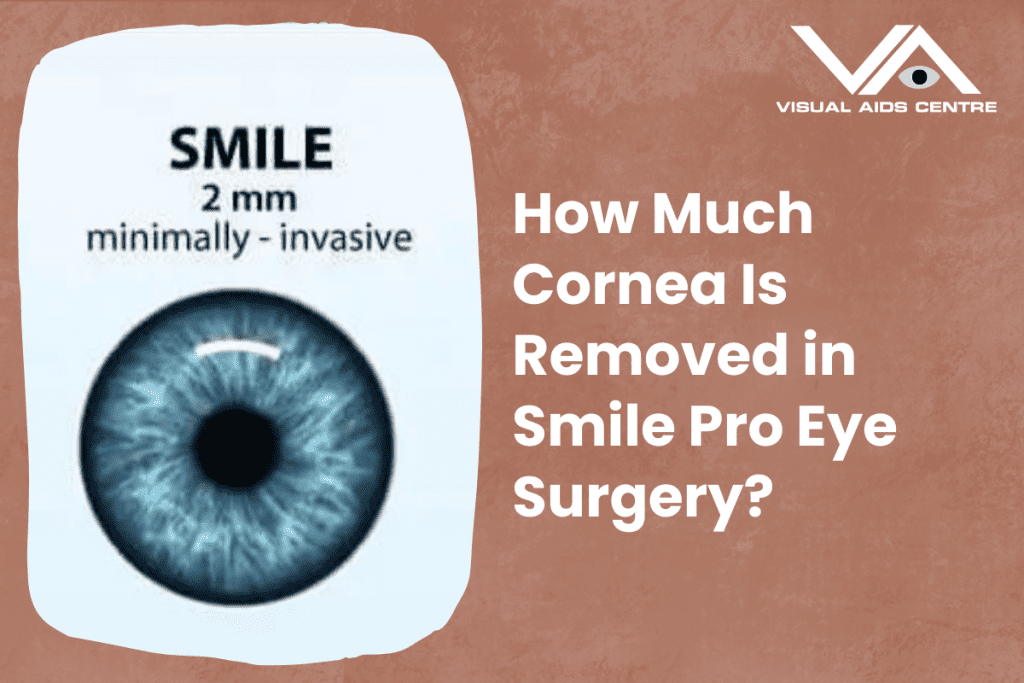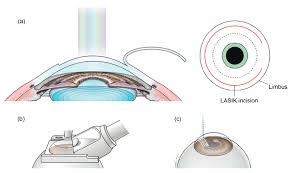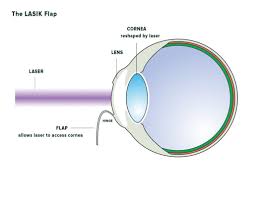Table of Contents
ToggleThe amount of cornea removed in SMILE Pro eye surgery is approximately 20%-30% less than what is removed during LASIK for the same vision correction.
For LASIK, around 12-16 microns of the cornea are removed per diopter of vision correction, while SMILE Pro achieves the same results using significantly less corneal tissue.

Understanding SMILE Pro Surgery
SMILE is a state-of-the-art laser eye surgery technique designed to correct nearsightedness (myopia), farsightedness (hyperopia), and astigmatism. The newly enhanced SMILE Pro procedure takes this innovation further with enhanced precision, faster recovery, and improved outcomes for patients. Unlike older procedures like LASIK, SMILE Pro utilises a minimally invasive, flapless approach.
This procedure utilises a femtosecond laser to create a precise, lens-shaped piece of tissue, referred to as a “lenticule,” within the cornea. The lenticule is subsequently extracted by the surgeon through a small incision. By reshaping the cornea in this way, SMILE Pro corrects refractive errors and improves vision with minimal disruption to the corneal structure.
Now, let’s explore how the amount of corneal tissue removed in SMILE Pro compares to LASIK and why this makes it appealing to certain patients.
Cornea Removal in LASIK vs. SMILE Pro
To appreciate the differences in corneal tissue removal, it’s important to understand how each procedure works:
- LASIK: During LASIK, a flap of the cornea is created and lifted. An excimer laser then reshapes the underlying corneal tissue by removing it layer by layer to correct refractive errors. LASIK typically removes 12 to 16 microns of corneal tissue per diopter of vision correction.
- SMILE Pro: SMILE Pro, on the other hand, skips the flap creation process. The lenticule is formed using a femtosecond laser and removed through a small incision. This method removes 20% to 30% less corneal tissue than LASIK for comparable correction. For the same diopter of correction, SMILE Pro is significantly more conservative in terms of how much corneal tissue is removed.
Why SMILE Pro Removes Less Corneal Tissue?
The reason SMILE Pro is less invasive lies in its advanced laser technology and flap-free approach. Instead of creating a large flap to access the corneal tissue, as in LASIK, SMILE Pro uses a small incision (approximately 2-4 mm). This focused approach allows the laser to reshape the cornea more efficiently while preserving more of the natural corneal structure.
By minimising the amount of tissue removed, SMILE Pro reduces the impact on the cornea’s strength and stability. This is particularly beneficial for patients with thinner corneas or those who may require additional corrective procedures in the future.
Benefits of Lower Corneal Tissue Removal
Removing less corneal tissue offers several advantages for patients considering SMILE Pro surgery:
1. Preserves Corneal Strength
Since SMILE Pro preserves more of the corneal structure, the cornea remains stronger after surgery. This can lower the risk of complications such as ectasia (a condition where the cornea weakens and bulges after laser surgery).
2. Safety for Thinner Corneas
Patients with thinner corneas who may not be candidates for LASIK are more likely to be eligible for SMILE Pro. This makes it an excellent option for those who still wish to undergo vision correction surgery.
3. Less Disruption to Nerve Endings
The small incision used in SMILE Pro means fewer corneal nerve fibers are affected during the procedure. This reduces the likelihood of postoperative dry eye, a common side effect of LASIK.
4. Faster Recovery
SMILE Pro’s minimally invasive nature often leads to quicker recovery times. Many patients experience minimal discomfort and return to their normal activities within a day.
5. Preserves Future Options
For patients who may need further vision correction as their eyes change with age, preserving more corneal tissue allows for greater flexibility with subsequent procedures.
Factors Affecting the Amount of Corneal Tissue Removed
It’s important to note that the amount of corneal tissue removed in SMILE Pro depends on several factors:
- Level of Refractive Error: The higher the degree of myopia, hyperopia, or astigmatism being corrected, the more corneal tissue needs to be removed. For example, someone correcting -6.00 diopters will require more tissue removal than someone correcting -2.00 diopters. Even so, SMILE Pro remains more conservative compared to LASIK.
- Corneal Thickness: The overall thickness of the patient’s cornea plays a role in determining the safety and eligibility for the procedure. A thicker cornea provides more tissue to work with, whereas thinner corneas require more careful planning.
- Surgeon Expertise: The surgeon’s skill and experience also matter. An expert surgeon can precisely calculate the amount of tissue to remove and ensure the best possible outcomes with minimal impact on the corneal structure.
Who Should Consider SMILE Pro?
While SMILE Pro offers key advantages, it’s not the ideal choice for everyone. Below are important considerations for candidates:
Ideal Candidates
- Patients with moderate to high myopia, hyperopia, and astigmatism
- Individuals with thinner corneas who are not suitable for LASIK
- Those who want a flapless, minimally invasive procedure
- Active individuals or athletes who are at higher risk of eye injuries (due to the absence of a flap)
Limitations of SMILE Pro
- The range of astigmatism correction is narrower compared to LASIK.
- Certain complex refractive errors may still require LASIK or other types of vision correction surgery.
A comprehensive consultation with an experienced ophthalmologist or refractive surgeon is the best way to determine if SMILE Pro is the right choice for your vision needs.
Final Thoughts
The reduced corneal tissue removal in SMILE Pro surgery is a significant advancement in the field of laser vision correction. By preserving more of the cornea, SMILE Pro offers benefits such as enhanced corneal strength, faster recovery, and fewer side effects, making it a preferred choice for many patients.
If you’re considering laser vision correction, understanding how much cornea is removed during the procedure is an important step in making an informed decision. Talk to your ophthalmologist about your unique vision needs and whether SMILE Pro is the right option for you.
With its precise and minimally invasive approach, SMILE Pro is reshaping the future of vision correction—one lenticule at a time.













